What Are Pipettes: Pipetting for Precision and Accuracy
December 29, 2022
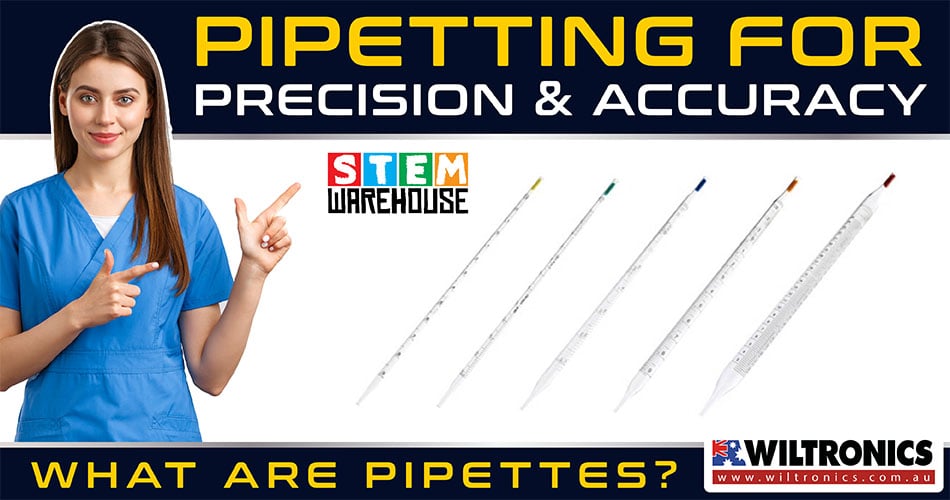
This guide will answer the question: what are pipettes? Plus, find out the importance of proper pipetting.
A pipette may be small, and its functions may be simple, but it plays a big role in lab procedures. It enables sterile and accurate liquid handling, where accuracy is paramount.
As straightforward as it seems to use, poor ‘pipetting’ technique can lead to unreliable data. Read on to learn what pipettes are and why you should not take correct pipetting for granted.
What are Pipettes?
“Pipette” is a French word that means “little pipe.” Also spelled as a pipet, it is a tube used for transferring liquids from one container to another.
Pipettes come in a variety of sizes, shapes, and designs for different applications. Generally, plastic and glass types can measure volumes less than 1 millilitre (mL). Electronic pipettes can measure volumes as small as 0.1 microliters (μL).
Some use a partial vacuum above the liquid-holding chamber to draw up and dispense the liquid. Pipettes have varying degrees of measurement precision. Either calibrated ‘to contain’ (TC) or ‘to deliver’ (TD) a specific volume.
TC pipettes will contain a specified volume but will not dispense the exact volume. Moreover, as a bit of solution remains in pipettes, TC models must be blown out. TD pipettes, in contrast, will dispense the exact volume. Items marked with a TD include graduated cylinders.
Types of Pipettes and their Applications
As mentioned, a pipette is usually made of either plastic or high-grade glass. Over the years, more manufacturers modified pipettes for various specific uses.
Below is a list of common types of pipettes and their uses:
Manual single-channel pipette
A manual single-channel pipette or micropipette is ergonomic. Ideal to use for simple yet repetitive liquid dispensing tasks of up to 5 mL. The ease of use makes it perfect for everyday use, especially when dealing with smaller sets of samples.
Get your pipette mirco tips here!
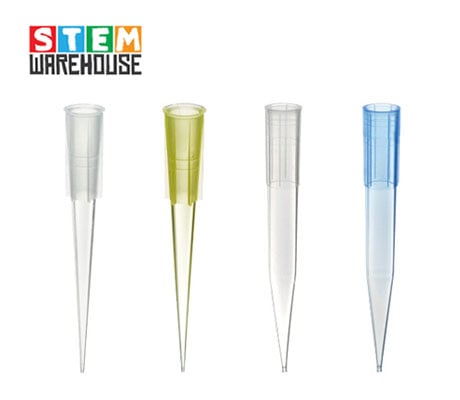
Pipette Micro Tips Pack of 100
Designed for use in a wide variety of pipetting applications. The clean hydrophobic surface ensures low retention, increased accuracy and reproducibility. Compatible with different types of u-pipettes and suitable for molecular biology and autoclavable.
Multichannel pipettes
A multichannel pipette is usually used to extract and dispense multiple liquid materials. It features 8 to 12 pipette heads, making micro plating tasks such as PCR and ELISA convenient.
8 to 12 channels can also take care of a 96-well microplate. Also, most multichannel pipettes are electronic. Such types can cut down several minutes of work when dealing with liquids. This is all thanks to their automated multi-dispensing capabilities.
Graduated pipettes
A graduated pipette is a type of macro pipette. It measures the volume of liquids larger than micropipettes can handle. And just like other types, it can be made either in plastic or borosilicate glass.
It features a tapered tip and a cylinder tube that bears the volume markings for measurement. When using one, hold the tip 6mm away from the bottom of the container for accuracy.
Also, know the specification of every graduated pipette you are using. Proper calibration means it delivers or extracts the proper amount.
If you see “AS” markings, the ‘A’ stands for high-level measurement precision. While ‘S’ means fast delivery or release of the liquid contained.
Serological pipettes
A serological pipette or terminal pipette falls under graduated pipettes. Ideal for mixing cell suspensions with marks identified closer to the tip.
Serological pipettes are convenient when experimenting with cell culture. Also, mixing or layering reagents, e.g. the ficolin gradients, to purify plasma cells from the blood.
Calibrated ones can hold and deliver liquid volumes from 0.1 to 25 ml. Get your serological pipette below!
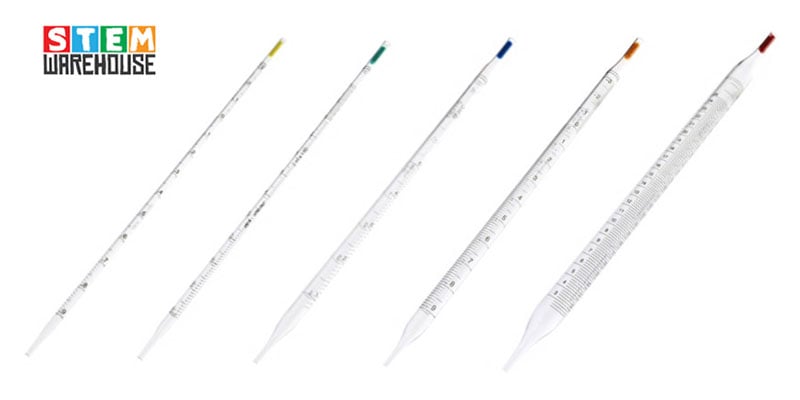
Pipette Serological Polystyrene Sterile
Made from polystyrene, they are economical and robust and feature graduations. Individually wrapped and certified non-pyrogenic and DNase, RNase free.
Each pipette has a colour-coded filter allowing for easy size identification. Accurate within ±2% at full volume.
Volumetric Pipettes
A volumetric pipette is designed for precision and accuracy. It features long with a narrow body bearing graduation marks for precise measurement. Plus, a bulb-shaped reservoir.
The typical volume ranges from 1, 2, 5, 10, 20, 25, 50, and 100 mL. Most, if not all, volumetric pipettes are borosilicate glass or pyrex-made. This means they can withstand pressure, sudden temperature changes, and more.
Get your volumetric pipette below!
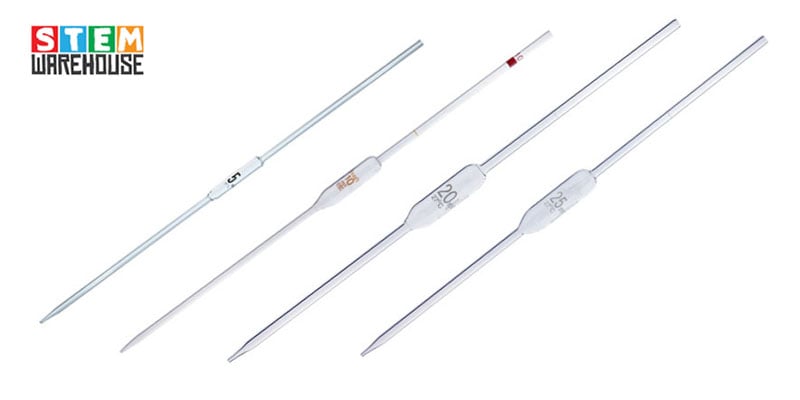
Volumetric Pipette
Features a single graduation for precise volume measurement.
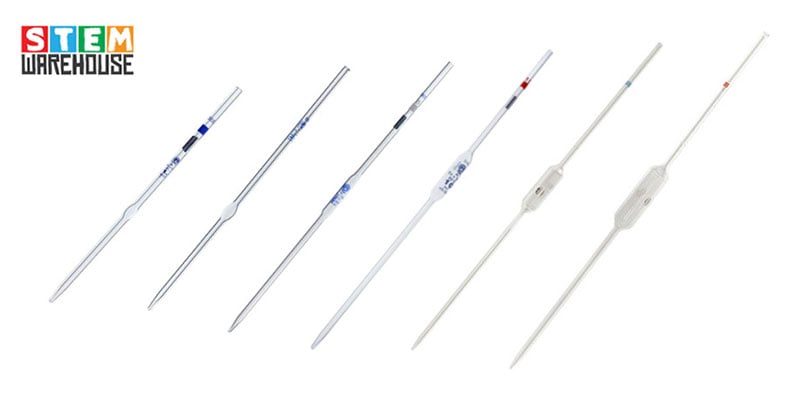
Volumetric Pipette Class A
Volumetric Pipette Class A with a single graduation mark for precise measurement. Certified type and conforms to ISO648 & BS1583. Also, supplied with a Work Certificate for each product.
Factors Affecting Pipetting Performance
Below are other factors that can impact pipetting performance. From the pipette itself to the tools that help with small-volume pipetting:
Pipette
- Accuracy
- Cleaning and maintenance
- System (air-cushion vs positive displacement vs manual vs electronic)
Pipette tip
- Quality (material properties)
- Correct fit (intact sealing)
- Size (air-cushion volume)
Liquid
- Aqueous
- Viscosity
- Vapour pressure
- Density
Environment
- Temperature
- Humidity
- Air pressure
Operator
- Experience
- Pipetting techniques
- Strain (RSI)
Knowing what impacts ‘random errors’ in pipetting help achieve ‘accurate and precise’ results. Even better when paired with the knowledge of pipetting techniques.
Pipetting Techniques for Precision and Accuracy
A proper pipetting technique is not complete without the aid of good tools, including:
Pipette and tip size
Always pair a pipette with the lowest nominal volume with the smallest tip. This combination helps keep the air cushion as small as possible.
When pipetting 1 µL, go for a 0.25 – 2.5 µL pipette and matching tip rather than a 1 – 10 µL pipette.
Calibration and maintenance
Your pipettes must be well-calibrated and maintained. Small adjustments, let alone broken parts, can lead to an increase in systematic errors.
As per ISO 8655, calibration must be performed within a time interval, e.g. three months but no more than one year. This will depend on the frequency of use, the number of operators using the pipets, and the nature of the liquids. The demands of the applications are also a factor.
Positive displacement pipettes
This pipette type offers a better pipetting result than classic air-cushion ones.
Larger volume usage
Consider diluting your sample to pipette larger volumes with the same quantity. This is especially important in the final reaction. as a result, it can reduce pipetting errors with very small sample volumes.
Besides the convenience of good tools, pay special attention to these techniques:
Tip attachment
Avoid jamming the pipette on the tip, otherwise, it will damage the fine tip end. This can also cause the liquid beam to be redirected to the orifice.
When attaching the tip, do it with light pressure. If possible, use a pipette with a spring-loaded tip cone.
Holding the pipette
Do not hold the pipette in your hand, for instance, while waiting for the centrifuge. The inside of a pipette is likely to heat up and lead the air cushion to expand. This results in deviations from the set volume when pipetting.
Pre-wetting
Pre-wetting means humidification of the air inside the tip and pipette. This method prepares the tip for the sample. At the same time, it avoids evaporation when aspirating the transfer volume.
Vertical aspiration
A crucial step, particularly when handling small volumes. Vertical aspiration helps avoid the capillary effect when the pipette is held at an angle.
Immersion depth
The smaller the tip and volume, the lower the immersion depth. Immerse the tip a little bit to prevent the liquid from entering the tip. Go for a 2 mm when pipetting small volumes.
Dispensing at a 45° angle
Hold the pipette at a 45° angle for optimal flow out of the liquid.
Contact with the vessel wall or liquid surface
Hold the tip against the vessel wall to dispense small volumes properly. Or immerse the tip into the liquid so even the last drop can be dispensed accurately.
Blow-out
This is essential after dispensing low volumes. The blow-out should also be carried out against the vessel wall. Be careful not to bring air bubbles into the sample when doing so.
The Bottom Line
Before you invest in a set of pipettes, think of what kinds of liquids you are going to use them for. This way, you know which type suits the application best.
Always take the time to calibrate your pipette. A good calibration maintenance practice is at least three to six months. This applies to manual and electronic pipettes.
And regardless of the type of pipette, care and attention are needed. Clean after every use to prevent contamination from any previous contents. For micropipettes, new plastic tips must be used each time.
© Electrotech Brands Pty Ltd 2022


Write a Comment
You must be logged in to post a comment.